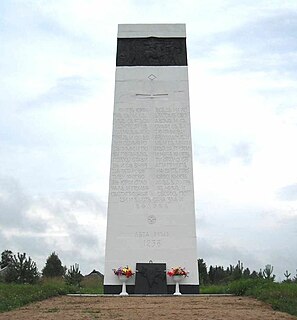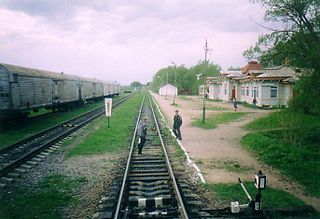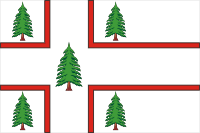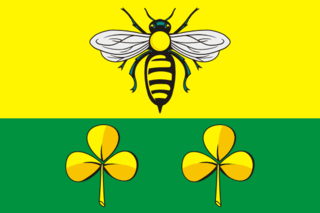| Mologa River Молога | |
|---|---|
 The lower course of the Mologa | |
| Location | |
| Country | Russia |
| Physical characteristics | |
| Source | |
| - location | Valdai Hills |
| Mouth | Rybinsk Reservoir (Volga) |
| - location | Russia |
| - coordinates | 58°52′59″N37°4′48″E / 58.88306°N 37.08000°E Coordinates: 58°52′59″N37°4′48″E / 58.88306°N 37.08000°E |
| - elevation | 101 m (331 ft) |
| Length | 456 km (283 mi) [1] |
| Discharge | |
| - average | 237 m3/s (8,400 cu ft/s) [1] |
| Basin features | |
| Basin size | 29,700 km2 (11,500 sq mi) [1] |

The Mologa (Russian : Молога) is a river in Maksatikhinsky, Bezhetsky, Lesnoy, and Sandovsky Districts of Tver Oblast, Pestovsky District in Novgorod Oblast, and Ustyuzhensky and Cherepovetsky Districts in Vologda Oblast Russia. It is a left tributary of the Volga River. The lower course of the Mologa has been turned into the Rybinsk Reservoir. It is 456 kilometres (283 mi) long, and the area of its basin 29,700 square kilometres (11,500 sq mi). The principal tributaries of the Mologa are the Osen (right), the Volchina (left), the Kobozha (left), the Chagodoshcha (left) and the Sit (right, now it is a tributary of the Rybinsk Reservoir).

Russian is an East Slavic language, which is official in the Russian Federation, Belarus, Kazakhstan and Kyrgyzstan, as well as being widely used throughout Eastern Europe, the Baltic states, the Caucasus and Central Asia. It was the de facto language of the Soviet Union until its dissolution on 25 December 1991. Although nearly three decades have passed since the breakup of the Soviet Union, Russian is used in official capacity or in public life in all the post-Soviet nation-states, as well as in Israel and Mongolia.

Maksatikhinsky District is an administrative and municipal district (raion), one of the thirty-six in Tver Oblast, Russia. It is located in the northeast of the oblast and borders with Lesnoy District in the north, Sandovsky and Molokovsky Districts in the northeast, Bezhetsky District in the east, Rameshkovsky and Likhoslavlsky Districts in the south, Spirovsky and Vyshnevolotsky Districts in the southwest, and with Udomelsky District in the west. The area of the district is 2,766 square kilometers (1,068 sq mi). Its administrative center is the urban locality of Maksatikha. Population: 16,723 ; 20,644 (2002 Census); 24,414 (1989 Census). The population of Maksatikha accounts for 52.3% of the district's total population.
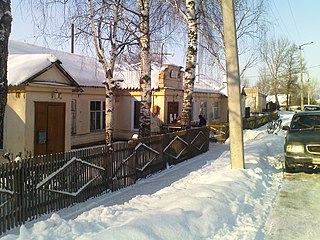
Bezhetsky District is an administrative and municipal district (raion), one of the thirty-six in Tver Oblast, Russia. It is located in the east of the oblast and borders with Molokovsky District in the north, Krasnokholmsky District in the northwest, Sonkovsky and Kesovogorsky Districts in the east, Kashinsky District in the southeast, Rameshkovsky District in the south, and with Maksatikhinsky District in the west. The area of the district is 2,810 square kilometers (1,080 sq mi). Its administrative center is the town of Bezhetsk. Population: 36,701 ; 14,277 (2002 Census); 18,786 (1989 Census). The population of Bezhetsk accounts for 66.8% of the district's total population.
The towns of Bezhetsk, Pestovo, and Ustyuzhna, and the urban-type settlement of Maksatikha are on the banks of the Mologa River. A historic town of Mologa used to stand at the confluence of the Mologa river with the Volga, but it was submerged under water as the Rybinsk Reservoir was filled between 1939 and 1947. The town of Vesyegonsk was also previously on the banks of the Mologa, however, it was relocated when the Rybinsk Reservoir was filled, and is on the banks of the reservoir.

Pestovo is a town and the administrative center of Pestovsky District in Novgorod Oblast, Russia, located in the Valdai Hills on the Mologa River. Population: 15,903 (2010 Census); 15,990 (2002 Census); 15,941 (1989 Census).
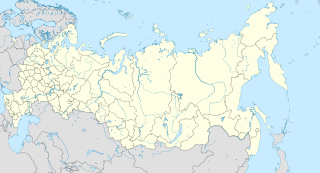
Ustyuzhna is a town and the administrative center of Ustyuzhensky District in Vologda Oblast, Russia, located on the Mologa River, 260 kilometers (160 mi) west of Vologda, the administrative center of the oblast. Population: 9,501 (2010 Census); 10,507 (2002 Census); 10,035 (1989 Census).

Maksatikha is an urban-type settlement and the administrative center of Maksatikhinsky District of Tver Oblast, Russia, with a population of 8,744 (2010 Census); 9,753 (2002 Census); 10,217 (1989 Census). It is located on the left bank of the Mologa River close to the mouth of the Volchina River.
The source of the Mologa is in the southeastern part of Maksatikhinsky District, in the eastern outskirts of Valdai Hills. The river flows east, enters Bezhetsky District, turns north, flows through the town of Bezhetsk, and flows into Lake Verestovo. It flows out of the lake in the western direction, reenters Maksatikhinsky District, flows through the urban-type settlement of Maksatikha and turns north. A stretch of the Mologa forms the border between Maksatikhinsky and Lesnoy Districts. The river crosses over to Lesnoy District, crosses it, flows at the border between Lesnoy and Sandovsky District and crosses into Novgorod Oblast. Downstream of the town of Pestovo the Mologa turns northeast and enters Vologda Oblast. There, it flows through the town of Ustyuzhna, accepts from the left the Kobozha and the Chagodoshcha, sharply turns southeast and flows into the Rybinsk Reservoir.

The Valdai Hills are an upland region in the north-west of central Russia running north-south, about midway between Saint Petersburg and Moscow, spanning Leningrad, Novgorod, Tver, Pskov, and Smolensk Oblasts.
The river basin of the Mologa comprises vast areas in the north of Tver Oblast, in the east of Novgorod Oblast, in the southeast of Leningrad Oblast (Boksitogorsky District), as well as the southeast of Vologda Oblast.

Leningrad Oblast is a federal subject of Russia. It was established on August 1, 1927, although it was not until 1946 that the oblast's borders had been mostly settled in their present position. The oblast was named after the city of Leningrad. Unlike the city, the oblast retains the name of Leningrad.

Boksitogorsky District is an administrative and municipal district (raion), one of the seventeen in Leningrad Oblast, Russia. It is located in the southeast of the oblast and borders with Tikhvinsky District in the north and west, Babayevsky District of Vologda Oblast in the east, Chagodoshchensky District of Vologda Oblast in the southeast, Khvoyninsky District of Novgorod Oblast in the south, and with Lyubytinsky District of Novgorod Oblast in the southwest. The area of the district is 7,200 square kilometers (2,800 sq mi). Its administrative center is the town of Boksitogorsk. Population : 15,695 (2010 Census); 17,698 ; 49,452 (1989 Census).
The lower course of the Mologa, downstream of the mouth of the Chagodoshcha, belongs to Tikhvinskaya water system, one of the waterways constructed in the early 19th century to connect the river basins of the Volga and the Neva. Currently, it is not used for any commercial navigation. [2]
The Tihvinskaya water system was one of the waterways connecting the Volga River with the Baltic Sea, and specifically the Mologa River with Syas River. In terms of the current administrative division of Russia, the waterway belongs to Vologda and Leningrad Oblasts.

The Neva is a river in northwestern Russia flowing from Lake Ladoga through the western part of Leningrad Oblast to the Neva Bay of the Gulf of Finland. Despite its modest length of 74 kilometres (46 mi), it is the fourth largest river in Europe in terms of average discharge.
Until the 1990s, the Mologa was used for timber rafting. The timber collecting facilities were in Pestovo. [3]

Timber rafting is a log transportation method in which logs are tied together into rafts and drifted or pulled across a water body or down a river. It is arguably the second cheapest method of transportation of timber, next after log driving. Both methods may be referred to as timber floating.
The river freezes up in late October through early December and stays under the ice until April or early May. [1]


